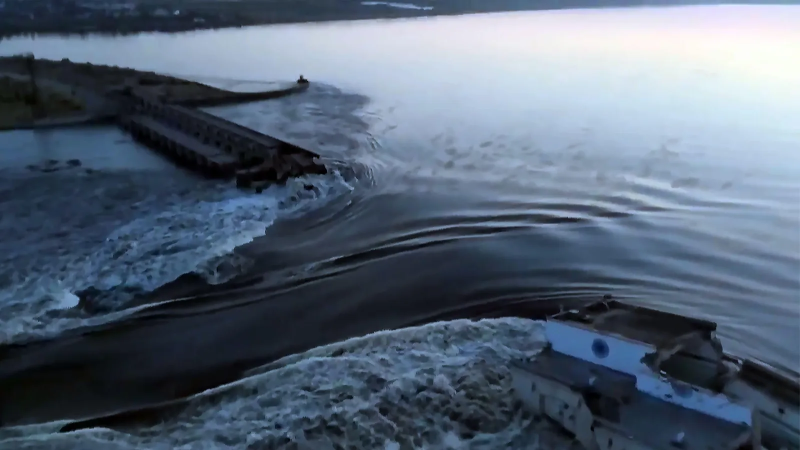- Train catches fire due to intense heat |
- BNP expels 73 leaders for contesting first phase of UZ polls |
- Chuadanga witnesses season’s highest temperature at 42.7°C |
- Dhaka, Bangkok to work together to deal with Rohingya issue: FM |
- Dhaka, Bangkok ink five bilateral documents |
Why Ukraine’s dam destruction is so catastrophic

Water from the Kakhovka reservoir, with a capacity of 18 cubic kilometres, flows through the damaged dam (Credit. Alamy) via BBC
When dam engineers plan for worst-case scenarios, sabotage is usually not part of their risk assessment.
"Normally we don't design dams thinking about war or explosives," says Rafael Moran of the Technical University of Madrid, a professor of civil engineering who specialises in dam protection. "It's not a hypothesis for designing."
Earlier this week, exploded mines placed on the Kakhovkadam in Ukraine released huge volumes of water from the Kakhovka reservoir into towns and farms downstream.
The catastrophic flooding has left hundreds of thousands of Ukrainians without normal access to drinking water.
Moran puts the scale of the release in context. "This reservoir holds 18 cubic km (4.7 trillion US gallons) of water," he says. "That's one third of all reservoir capacity in Spain."
The Kakhovka dam was constructed along the Dnipro River in the 1950s as part of Soviet leader Joseph Stalin's plans to change the natural character of the region, and what he saw as the unpleasant features of the wetlands. Around 34,000 people were resettled.
"By controlling the wetlands, making them disappear under a new man-made sea, the [Soviet] regime consolidated its economic and political presence in the territory. A technological environment controlled exclusively by the party replaced an environment that had been difficult to control," write environmental historians Stefan Dorendel and Anna Olenenko in the book A New Ecological Order, about the transformation of nature in Eastern Europe.
So, the irony is that, if Russia is to blame (the BBC could not verify Ukraine's claims on Tuesday) then it would be a military decision that reverses that enormous undertaking.
Historic breaches
Such catastrophic dam breaches are rare. But when they happen, they can often change the way that future dams are designed and risk-assessed.
Some examples of comparable catastrophes from history include:
• The failure of Algeria's Bouzey and Habra dams in the late 1800s opened engineers' eyes to the effect of "uplift pressure", a vertical force caused by the weight of the water at the base of the dam.
• The Malpasset dam breach in France, which killed more than 400 people in 1959. In that case, analysis afterwards revealed a hitherto unknown geological weakness beneath the concrete foundations that was displaced by the dam's weight. Engineers and geologists must now design and check for such issues before construction.
• The disaster at the Vajont dam in Italy, which overflowed in 1963 when a landslide fell into the reservoir and caused a tsunami. It led engineers to include the risk of slope instability above the reservoir in their assessments. "Before this, mass sliding was not considered a problem," says Moran.
• The 1976 failure of Teton dam in Idaho, US, killed 11 people and caused around $400m (£320m) in damage. Investigations revealed design deficiencies and poorly implemented construction in the foundation that ignored the local geology, and allowed for internal erosion and cracking.
Many dam risk assessments completed nowadays are focused on preparing for events on a less catastrophic scale. Nonetheless, dam failures are surprisingly common. In the US, where there are more than 90,000 dams, there have been on average 10 failures per year since the mid-1800s, although only 3.8% of those failures have resulted in one or more fatalities.
One particularly pernicious problem for dam engineers nowadays is climate change. The threat of "overtopping" is increasingly a failure risk for old dams, designed when maximum flooding levels were lower. "The spillways don't have enough capacity," says Moran.
Adapting spillways to cope with this extra water can be expensive, but there are simple-but-innovative solutions, like placing concrete slabs to form a kind of gutter on the dry downslope of a dam to catch the overtopped water and redirect it, he explains.
It's perhaps too early to say how – or if – the Ukraine catastrophe will influence future dam design.
Moran understands the US Army has conducted tests to see how vulnerable US dams might be to explosive sabotage, but they haven't made the results public.
However, he points out that for many large dams made of concrete (masonry dams) or earth (embankment dams), sabotage of the kind seen in Ukraine would not be so straightforward. You'd need a huge explosion to cause damage to a structure like, say, the concrete Hoover Dam, because it is so robust and wide.
What made the Kakhovka dam vulnerable, Moran explains, was that water flow was controlled with metal gates, which would have been relatively easy to breach with mines.
That relative ease of destruction has made the Kakhovka breach into a dam failure on a scale not seen in Europe for decades.
The consequences will likely drag on for months – and not just in terms of the immediate damage. For decades, the water from the Kakhovka reservoir has helped to irrigate farmland across the region, which was previously arid in the hot summer months. "It will have consequences for the agriculture sector in Ukraine," says Moran. "And that is very big because they are feeding the world." – BBC News

